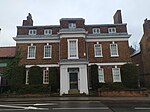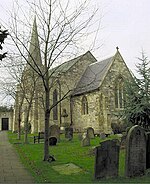Acomb, North Yorkshire

Acomb , is a village and suburb within the City of York unitary authority area, to the western side of York, England. It covers the site of the original village of the same name, which is mentioned in the Domesday Book of 1086. It is bordered by the suburbs of Holgate, to the east, Clifton, to the north and Woodthorpe to the south. The boundary to the west abuts the fields close to the A1237, York Outer Ring Road. Historically part of the West Riding of Yorkshire, Acomb was incorporated into the City of York in 1934.Formerly a farming village, Acomb expanded over the centuries to become a dormitory area for workers in heavy industry, such as rail engineering, in the 19th and 20th centuries and more recently for a more diverse workforce. Though it no longer has any large-scale manufacturing, it does have a diverse retail centre. There are at least 19 Grade II listed buildings within its boundaries. It was made a Conservation Area in 1975, with the historic area along Front Street and the Green retaining its village character. It is also an Area of Archaeological Importance under the Ancient Monuments and Archaeological Areas Act 1979. Acomb comprises two wards of the City of York: Acomb and Westfield. At the 2011 Census of England and Wales, it had a population of 22,215, the largest of all areas of the city. There are six primary schools and one comprehensive school. There are also a variety of sporting clubs and one public sports centre. Acomb is famous in York for having a very high concentration of street bollards. These were installed in an upgrade in 2023 and have since prompted great controversy among local residents due to their vast numbers and variance from the original proposed plans for the area.
Excerpt from the Wikipedia article Acomb, North Yorkshire (License: CC BY-SA 3.0, Authors, Images).Acomb, North Yorkshire
Front Street, York Acomb
Geographical coordinates (GPS) Address Website Nearby Places Show on map
Geographical coordinates (GPS)
| Latitude | Longitude |
|---|---|
| N 53.955 ° | E -1.126 ° |
Address
Morrisons
Front Street 4
YO24 3BZ York, Acomb
England, United Kingdom
Open on Google Maps









